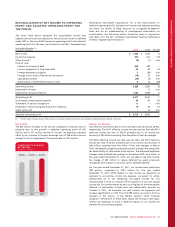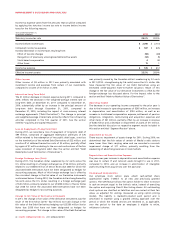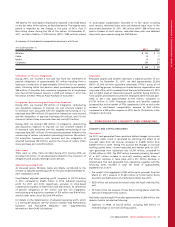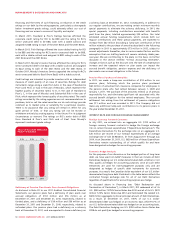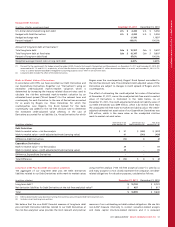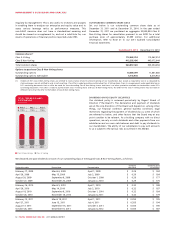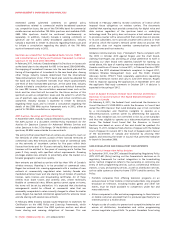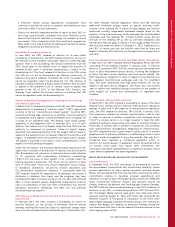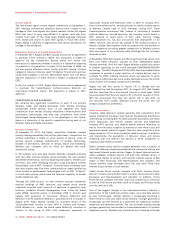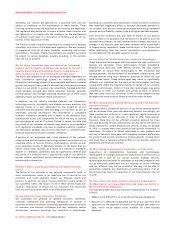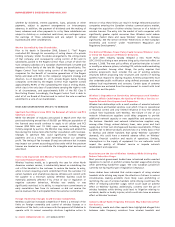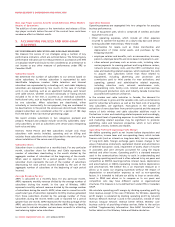Rogers 2011 Annual Report Download - page 58
Download and view the complete annual report
Please find page 58 of the 2011 Rogers annual report below. You can navigate through the pages in the report by either clicking on the pages listed below, or by using the keyword search tool below to find specific information within the annual report.
MANAGEMENT’S DISCUSSION AND ANALYSIS
OFF-BALANCE SHEET ARRANGEMENTS
Guarantees
As a regular part of our business, we enter into agreements that
provide for indemnification and guarantees to counterparties in
transactions involving business sale and business combination
agreements, sales of services and purchases and development of
assets. Due to the nature of these indemnifications, we are unable to
make a reasonable estimate of the maximum potential amount we
could be required to pay counterparties. Historically, we have not
made any significant payment under these indemnifications or
guarantees. Refer to Note 18(e)(ii) to the 2011 Audited Consolidated
Financial Statements.
Derivative Instruments
As previously discussed, we use derivative instruments to manage our
exposure to interest rate and foreign currency risks. We do not use
derivative instruments for speculative purposes.
Operating Leases
We have entered into operating leases for the rental of premises,
distribution facilities, equipment and microwave towers and other
contracts. The effect of terminating any one lease agreement would
not have an adverse effect on us as a whole. Refer to the section
entitled “Contractual Obligations” above and Note 25 to the 2011
Audited Consolidated Financial Statements.
4. OPERATING ENVIRONMENT
Additional discussion of regulatory matters and recent developments
specific to the Wireless, Cable and Media segments follows.
GOVERNMENT REGULATION AND REGULATORY DEVELOPMENTS
Substantially all of our business activities, except for Cable’s Video
segment and the non-broadcasting operations of Media, are subject
to regulation by one or more of: the Canadian Federal Department of
Industry, on behalf of the Minister of Industry (Canada) (collectively,
“Industry Canada”), the CRTC under the Telecommunications Act
(Canada) (the “Telecommunications Act”) and the CRTC under the
Broadcasting Act (Canada) (the “Broadcasting Act”), and, accordingly,
our results of operations are affected by changes in regulations and
by the decisions of these regulators.
Canadian Radio-television and Telecommunications Commission
Canadian broadcasting operations, including our cable television
systems, radio and television stations, and specialty services are
licenced (or operated pursuant to an exemption order) and regulated
by the CRTC pursuant to the Broadcasting Act. Under the
Broadcasting Act, the CRTC is responsible for regulating and
supervising all aspects of the Canadian broadcasting system with a
view to implementing certain broadcasting policy objectives
enunciated in that Act.
The CRTC is also responsible under the Telecommunications Act for
the regulation of telecommunications carriers, which includes the
regulation of Wireless’ mobile voice and data operations and Cable’s
Internet and telephone services. Under the Telecommunications Act,
the CRTC has the power to forbear from regulating certain services or
classes of services provided by individual carriers. If the CRTC finds
that a service or class of services provided by a carrier is subject to a
degree of competition that is sufficient to protect the interests of
users, the CRTC is required to forbear from regulating those services
unless such an order would be likely to unduly impair the
establishment or continuance of a competitive market for those
services. All of our Cable and telecommunications retail services have
been deregulated and are not subject to price regulation. However,
regulations can and do affect the terms and conditions under which
we offer these services. Accordingly, any change in policy, regulations
or interpretations could have a material adverse effect on Cable’s
operations and financial condition and operating results.
Industry Canada
The technical aspects of the operation of radio and television stations,
the frequency-related operations of the cable television networks and
the awarding and regulatory supervision of spectrum for cellular,
messaging and other radio-telecommunications systems in Canada are
subject to the licencing requirements and oversight of Industry
Canada. Industry Canada may set technical standards for
telecommunications under the Radiocommunication Act (Canada)
(the “Radiocommunication Act”) and the Telecommunications Act.
Copyright Board of Canada
The Copyright Board of Canada (“Copyright Board”) is a regulatory
body established pursuant to the Copyright Act (Canada) (the
“Copyright Act”) to oversee the collective administration of copyright
royalties in Canada and to establish the royalties payable for the use
of certain copyrighted works. The Copyright Board is responsible for
the review, consideration and approval of copyright tariff royalties
payable to copyright collectives by Canadian broadcasting
undertakings, including cable, radio, television and specialty services.
Restrictions on Non-Canadian Ownership and Control
Non-Canadians are permitted to own and control directly or indirectly
up to 33.3% of the voting shares and 33.3% of the votes of a holding
company that has a subsidiary operating company licenced under the
Broadcasting Act. In addition, up to 20% of the voting shares and
20% of the votes of the operating licencee company may be owned
and controlled directly or indirectly by non-Canadians. The chief
executive officer and 80% of the members of the Board of Directors
of the operating licencee must be resident Canadians. There are no
restrictions on the number of non-voting shares that may be held by
non-Canadians at either the holding-company or licencee-company
level. Neither the Canadian carrier nor its parent may be otherwise
controlled in fact by non-Canadians. Subject to appeal to the federal
Cabinet, the CRTC has the jurisdiction to determine as a question of
fact whether a given licencee is controlled by non-Canadians.
Pursuant to the Telecommunications Act and associated regulations,
the same rules apply to Canadian carriers such as Wireless, except that
there is no requirement that the chief executive officer be a resident
Canadian. The same restrictions are contained in the
Radiocommunication Act and associated regulations.
In its March 2010 Budget, the federal government announced its
intention to remove the existing restrictions on foreign ownership of
Canadian satellites (subsequently passed into law in the fall of 2010).
The government also announced that it would review the foreign
ownership restrictions currently applied to telecommunications
companies. In June 2010, Industry Canada released its consultation
paper on this matter asking for comments by July 2010 on three
options:
1. Increasing the limit for direct foreign investment in broadcasting
and telecommunications common carriers to 49 percent;
2. Lifting restrictions on telecommunications common carriers with
a 10 percent market share or less, by revenue; or
3. Removing telecommunications restrictions completely.
Rogers filed its comments in July 2010 submitting that of the three
options only option 1 was acceptable because options 2 and 3 fail to
recognize the converged market for communications services in
54 ROGERS COMMUNICATIONS INC. 2011 ANNUAL REPORT



